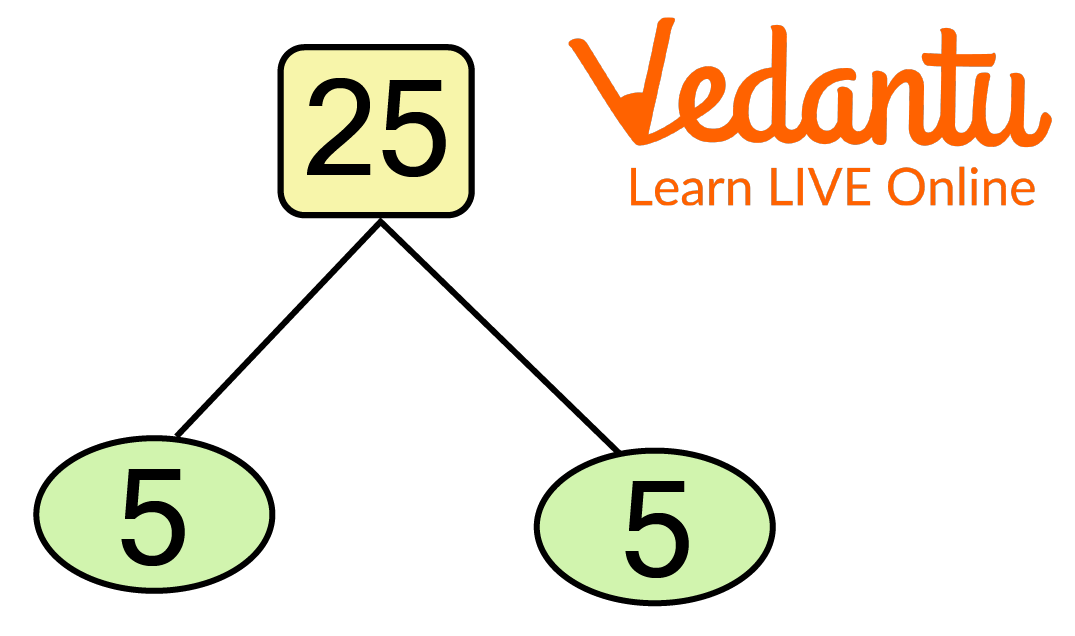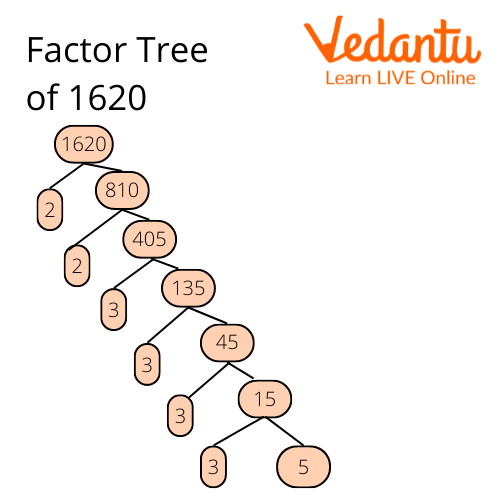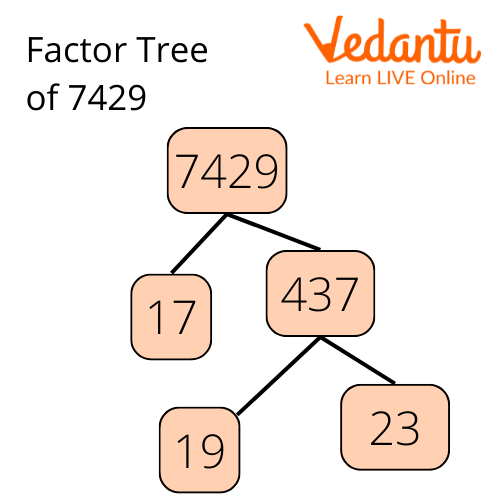




How to Find and Use Prime Factors of 25 in Maths
A prime number can only be divided by itself and one without leaving any remains. Whenever you divide a prime number by another natural number, you get numbers left over. Every other natural number is made up of prime number factors. Simply put, a number’s prime factors are the prime numbers that are multiplied to generate the original number. For example, the prime factors of 25 are 5 and 5, i.e, $5 \times 5=25$. This article will help you understand the concepts of prime factors in general.
What is Prime Factorization?
Prime factorization is simply a process in which a number is broken down into prime numbers that help construct the number when multiplied. In other words, prime numbers are multiplied together to get the original number. Here are some prime factorization examples:
8 = $2 \times 2 \times 2=2^{3}$
18 = $2 \times 3 \times 3=2 \times 3^{2}$
25 = $5 \times 5=5^{2}$
20 = $2 \times 2 \times 5=2^{2} \times 5$
Methods for Prime Factorization
There are several methods for prime factoring an integer. The most frequent methods for prime factorization are:
Factor tree method
Division method
Factor Tree Method
This method places the given number on top of the factor tree. The relevant pairs of factors are then written as the tree's branches. Following this, the composite factors are factored in and written down as the next branches.
The following steps are used to find out what are the prime factors of a 25 using the factor tree method:
First, above the factor tree, put the number 25.
Then, write down the relevant pair of factors in tree branches.
Factorise the composite factors discovered in step 2 and record the pair of factors as the tree's next branches.
Repetition of step 3 is required to obtain the prime factors for each composite factor.

Prime Factorization of 25 Using Tree Method
Division Method
In this method, the given integer is divided by the smallest prime number that entirely divides it. The quotient is then divided by the smallest prime integer once more. This process is repeated until the quotient equals one.
The following steps are used to find out the prime factors of 25 using the division method:
Divide 25 by the lowest prime number, in this case, 5, ensuring that the smallest prime number entirely divides the number.
Divide the quotient of step 1 (5) by the smallest prime integer (5) once more.
Repeat step 2 until the quotient equals one.
Finally, multiply all of the divisors' prime factors to get the products of the prime factors of 25.

Prime Factorization of 25 Using Division Method
Solved Examples
1. Find the prime factors of 64.
Ans: Prime factors of 64 = 2 × 2 × 2 × 2 × 2 × 2 = 26
2. Find the prime factors for 1620.
Ans: To find the factors of 1620, you can use the factor tree method. The prime factorization of 1620 = 2 × 2 × 3 × 3 × 3 × 3 × 5.

Prime Factorization of 1620 Using Tree Method.
3. Find the prime factors of 7429.
Ans: We can find the prime factors of 7429 by either factor tree or divisional method.
Using the divisional method, we can get prime factors 17 x 19 x 23.

Prime Factorization of 7429 Using Tree Method
Practice Questions
1. Find the Prime Factor of 544 using the factorial tree method.
Ans: The prime factorization of 544 is 2×2×2×2×2×17 or 24 x 17.
2. Find the prime factors of 1000.
Ans: The prime factorization of 1000 is 2 x 2 x 2 x 5 x 5 x 5 or 23 x 53.
3. Find the prime numbers of 45.
Ans: The prime factorization of 45 is 3 × 3 × 5 or 32 × 5.
4. Find the prime numbers of 88.
Ans: The prime factors of 88 are 2 and 11.
5. Find the prime numbers of 50.
Ans: The prime factors of 50 are 2 × 5 × 5 or 2 × 52
Summary
As we have discussed earlier, Prime factorization is the process of breaking down a number into prime numbers that help construct the number when multiplied. There are two ways for prime factorization of any number. In the method of division, the given integer is divided by the smallest prime number that entirely divides it until the quotient equals one. The prime factors that are divisors are then multiplied. In the Method of the factor tree, the given number is placed on top of the factor tree. The relevant pairs of factors are then written as the tree's branches. Following this, the composite factors are factored in and written down as the next branches until all of the composite factors' prime factors are obtained.
FAQs on Prime Factors of 25 Explained with Simple Steps
1. What are the prime factors of 25?
The only prime factor of 25 is 5. When we perform prime factorization for the number 25, we get 5 × 5, which can also be written in exponential form as 5². Although 25 has three factors in total (1, 5, and 25), only the number 5 is a prime number.
2. How can I find the prime factors of 25 using the division method?
To find the prime factors of 25 using the division method, you follow these steps:
Step 1: Start with the smallest prime number, which is 2. Check if 25 is divisible by 2. It is not.
Step 2: Move to the next prime number, 3. Check if 25 is divisible by 3. It is not.
Step 3: Move to the next prime number, 5. Divide 25 by 5, which gives a quotient of 5. (25 ÷ 5 = 5).
Step 4: The quotient is 5, which is also a prime number. Divide it by 5, which gives a quotient of 1. (5 ÷ 5 = 1).
The prime divisors we used are 5 and 5. Therefore, the prime factorization of 25 is 5 × 5.
3. What is the difference between the factors and the prime factors of 25?
The main difference lies in the definition of 'factor' versus 'prime factor'.
Factors of 25 are all the numbers that can divide 25 without leaving a remainder. The factors of 25 are 1, 5, and 25.
Prime factors of 25 are the prime numbers from that list of factors which, when multiplied together, produce the original number. Out of 1, 5, and 25, only 5 is a prime number.
So, while 25 has three factors, its prime factorization consists only of the prime number 5, written as 5 × 5.
4. Why is the number 25 considered a composite number and not a prime number?
A number is classified as prime if it has exactly two factors: 1 and the number itself. The number 25 has factors 1, 5, and 25. Since it has more than two factors (it is divisible by 5 in addition to 1 and 25), it does not meet the definition of a prime number. Any whole number greater than 1 with more than two factors is called a composite number.
5. How does the factor tree method work for finding the prime factors of 25?
The factor tree method is a visual way to break down a number into its prime factors. For 25, the process is very straightforward:
Start with the number: Write 25 at the top of the tree.
Find two factors: Draw two branches from 25 and write two numbers that multiply to give 25. The obvious choice is 5 × 5.
Check for prime numbers: Look at the numbers at the end of the branches (5 and 5). Since both are prime numbers, the process stops here.
The prime factors are the numbers at the ends of the tree's branches, which are 5 and 5.
6. What is the importance of knowing the prime factors of a number like 25?
Understanding the prime factors of a number is a fundamental concept in mathematics with several important applications. For the number 25, knowing its prime factors (5 × 5) helps in:
Finding Square Roots: Because the prime factors form an identical pair (5 and 5), we can easily identify that 25 is a perfect square and its square root is 5.
Calculating HCF and LCM: Prime factorization is the primary method used to find the Highest Common Factor (HCF) and Lowest Common Multiple (LCM) between two or more numbers.
Simplifying Fractions: It helps in simplifying fractions to their lowest terms by cancelling out common prime factors in the numerator and denominator.
7. Can a number have more than one unique set of prime factors? For example, can 25 be factored into other primes besides 5 x 5?
No, a number cannot have more than one unique set of prime factors. This principle is confirmed by the Fundamental Theorem of Arithmetic. This theorem states that every whole number greater than 1 is either a prime number itself or can be expressed as a product of prime numbers in a unique way, regardless of the order of the factors. Therefore, the only prime factorization for 25 is 5 × 5. No other combination of prime numbers will ever multiply to equal 25.

















